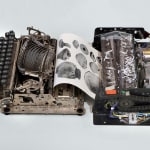Nicolás Lamas
Transient data, 2024
Typewriter, shredder machine and paper
53 x 36 x 10 cm
20 7/8 x 14 1/8 x 4 inches
20 7/8 x 14 1/8 x 4 inches
Copyright The Artist
Photo: Studio Nicolás Lamas
Weitere Abbildungen
Die Skulpturen von Nicolás Lamas, die sich aus organischen Elementen, präzise gefertigten Strukturen und gebrauchten Alltagsgegenständen zusammensetzen, wirken wie hybride Artefakte, die verschiedene Zeitlinien miteinander verbinden. Sie spiegeln das Interesse...
Die Skulpturen von Nicolás Lamas, die sich aus organischen Elementen, präzise gefertigten Strukturen und gebrauchten Alltagsgegenständen zusammensetzen, wirken wie hybride Artefakte, die verschiedene Zeitlinien miteinander verbinden. Sie spiegeln das Interesse des Künstlers an Archäologie und der Entwicklung technischer Errungenschaften über Jahrtausende hinweg wider. „Technologie entwickelt sich weiter und blickt in die Zukunft, während die Archäologie eine Disziplin ist, die per Definition ständig Daten aus der Vergangenheit sammelt – anhand der materiellen Spuren, die unsere Vorfahren hinterlassen haben. Manchmal vergessen wir jedoch, dass sich sowohl die Vergangenheit als auch die Zukunft ständig weiterentwickeln.“ Die Assemblagen eröffnen Dialoge über Vergänglichkeit, Hybridität und die Trennung von Kultur und Natur. Die verschiedenen Materialitäten scheinen zunächst konträr zueinander zu stehen, weisen aber bei genauerer Betrachtung formale und inhaltliche Gemeinsamkeiten auf. Die einzelnen Elemente besitzen für den Künstler eine eigene Kraft, durch die die Unterscheidung zwischen menschengemacht und organisch gewachsen hinfällig wird. Durch diese Begegnungen versucht Lamas, die Funktion und den Wert der Dinge zu relativieren und andere Wege zu eröffnen, um ihre Existenz neu zu definieren.
„Transient data“ (2024) reflektiert die Weitergabe von Wissen im Lauf der Menschheitsgeschichte und wie es durch neue Technologien sowohl bewahrt als auch verloren gehen kann. Während eine Schreibmaschine das Bild eines der wichtigsten kulturhistorischen Objekte – eines Gefäßes – zeichnet, wird dieses auf der anderen Seite bereits durch einen Schredder gezogen und zerfasert. Der Kreislauf suggeriert Fortschritt und verdeutlicht, wie sich Werkzeuge und Technologien verändern und an neue Bedürfnisse anpassen – und erinnert gleichzeitig an die Erosion und den Wandel von Materialien über die Zeit hinweg.
Nicolas Lamas' sculptures, composed of organic elements, precisely produced structures, and used everyday objects, resemble hybrid artifacts that connect different timelines. They reflect the artist’s interest in archaeology and the development of technological achievements over millennia. “Technology continues to advance and looks toward the future, while archaeology is a discipline that, by definition, constantly gathers data from the past through the material traces left by our ancestors. However, we sometimes forget that both the past and the future are in constant evolution.” The assemblages thus open dialogues about transience, hybridity, and the separation of culture and nature. At first glance, the different materials appear to be in opposition to each other, but upon closer examination, they reveal formal and thematic similarities. For the artist, the individual elements possess their own power, making the distinction between man-made and organically grown irrelevant. Through these encounters, Lamas seeks to relativize the function and value of objects, opening up new ways to redefine their existence.
“Transient data” (2024) reflects on the transmission of knowledge over the course of human history and how it can be both preserved and lost through new technologies. While a typewriter draws the image of one of the most important cultural-historical objects - a vessel - it is already being pulled through a shredder and defibered on the other side. The cycle suggests progress and illustrates how tools and technologies change and adapt to new needs - and at the same time reminds us of the erosion and transformation of materials over time.
„Transient data“ (2024) reflektiert die Weitergabe von Wissen im Lauf der Menschheitsgeschichte und wie es durch neue Technologien sowohl bewahrt als auch verloren gehen kann. Während eine Schreibmaschine das Bild eines der wichtigsten kulturhistorischen Objekte – eines Gefäßes – zeichnet, wird dieses auf der anderen Seite bereits durch einen Schredder gezogen und zerfasert. Der Kreislauf suggeriert Fortschritt und verdeutlicht, wie sich Werkzeuge und Technologien verändern und an neue Bedürfnisse anpassen – und erinnert gleichzeitig an die Erosion und den Wandel von Materialien über die Zeit hinweg.
Nicolas Lamas' sculptures, composed of organic elements, precisely produced structures, and used everyday objects, resemble hybrid artifacts that connect different timelines. They reflect the artist’s interest in archaeology and the development of technological achievements over millennia. “Technology continues to advance and looks toward the future, while archaeology is a discipline that, by definition, constantly gathers data from the past through the material traces left by our ancestors. However, we sometimes forget that both the past and the future are in constant evolution.” The assemblages thus open dialogues about transience, hybridity, and the separation of culture and nature. At first glance, the different materials appear to be in opposition to each other, but upon closer examination, they reveal formal and thematic similarities. For the artist, the individual elements possess their own power, making the distinction between man-made and organically grown irrelevant. Through these encounters, Lamas seeks to relativize the function and value of objects, opening up new ways to redefine their existence.
“Transient data” (2024) reflects on the transmission of knowledge over the course of human history and how it can be both preserved and lost through new technologies. While a typewriter draws the image of one of the most important cultural-historical objects - a vessel - it is already being pulled through a shredder and defibered on the other side. The cycle suggests progress and illustrates how tools and technologies change and adapt to new needs - and at the same time reminds us of the erosion and transformation of materials over time.







